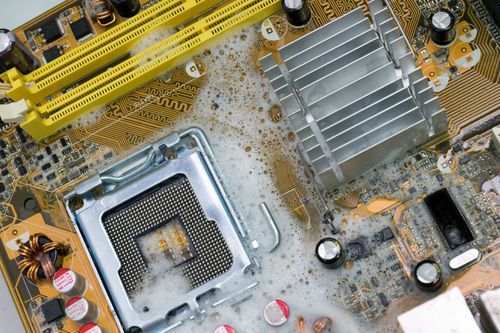
The Hidden Risks of Partially Cleaning PCBs
In high-reliability electronics, cleaning is not optional — it’s essential. But what’s even more dangerous than not cleaning at all? Partially cleaning your PCB assemblies. Incomplete cleaning leaves behind a deceptive surface: it may look clean to the naked eye, but beneath the surface, dangerous residues can remain, silently threatening the performance and lifespan of your product.
Residual Contamination: A Ticking Time Bomb
Partial cleaning often removes some visible residues, while leaving behind hidden pockets of flux, solder paste, or process chemicals — especially under Bottom Terminated Components (BTCs), dense connectors, and shadowed areas. These residues don’t just sit there — they interact with the environment.
What This Means for Reliability:
Residual contamination acts as a trap for moisture, accelerating corrosion and dendritic growth over time. It creates the ideal conditions for electrical leakage, intermittent failures, and latent shorts. Surface Insulation Resistance (SIR) testing is essential to simulate these conditions and measure the real-world risk your product may face after partial cleaning.
Ionic Contamination: Invisible, Conductive, and Destructive
When cleaning is incomplete, ionic contaminants — such as flux activators, organic acids, and process residues — can remain. Even trace levels are enough to cause serious problems in a humid environment.
Why This Is Dangerous:
Ionic residues are conductive. In the presence of moisture, they can cause electrochemical migration, corrosion, and leakage currents. And unlike visual residues, ionic contamination often goes completely unnoticed — until your product fails in the field.
Our Solution:
At Magnalytix, we use Ion Chromatography (IC) testing — a gold standard analytical method — to precisely quantify ionic contamination levels. Combined with SIR and C3 testing, this gives you a full picture of how your cleaning process is performing. These tools allow us to identify whether partial cleaning is leaving behind harmful residues and help you refine your process to eliminate them.
Complex Components: Where Partial Cleaning Fails the Most
Modern PCBAs are densely populated with Bottom Terminated Components (BTCs), QFNs, BGAs, and pin headers — all of which create areas that are nearly impossible to clean manually or with standard equipment. Partial cleaning might appear effective, but residues can be trapped underneath components, where they continue to corrode, interact, and fail over time.
The Risk:
Trapped residues are almost impossible to detect visually and are the root cause of many latent field failures. Once encapsulated, they’re also much harder to remove — making early detection and prevention critical.
Magnalytix’s Approach:
We offer purpose-built test boards — including the B-52 Legacy 2, BGA 10, and QFN 11 — specifically designed to mimic these challenging geometries. These allow you to validate your cleaning process under worst-case scenarios. If you’re partially cleaning and not validating, you’re risking undetected failure mechanisms.
Conclusion: Partial Cleaning = Partial Reliability
Partial cleaning gives a false sense of security. The board may look clean, but it’s not truly clean — and the hidden contamination left behind can significantly shorten product life, increase field returns, and damage your reputation. The consequences range from corrosion and intermittent failures to catastrophic shorts — all because the job wasn’t fully done.
At Magnalytix, we don’t just run tests. We help you uncover what’s really going on beneath the surface. Through advanced SIR, IC, and C3 testing, we provide the data — and more importantly, the insights — to optimize your cleaning process. Whether you’re cleaning no-clean fluxes, evaluating rinse stages, validating new solder pastes, or validating new chemistries, we help you avoid the dangers of partial cleaning before they become product failures.
Even if your board is unique, we’ll engineer a custom test card tailored to your layout, complete with Gerber files, components, and expert guidance. We’ll help you build a DOE that gives you confidence in your process — and in your product.
Contact us today to make sure your boards are truly clean — not just partially clean.